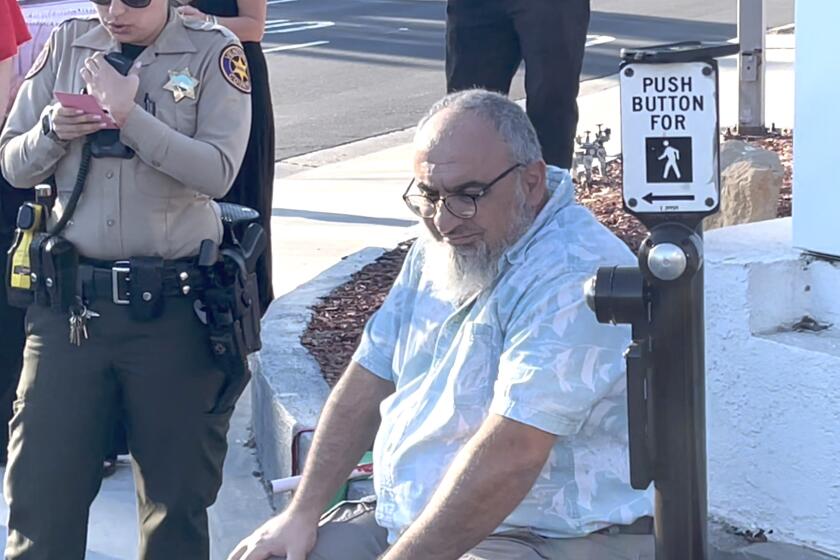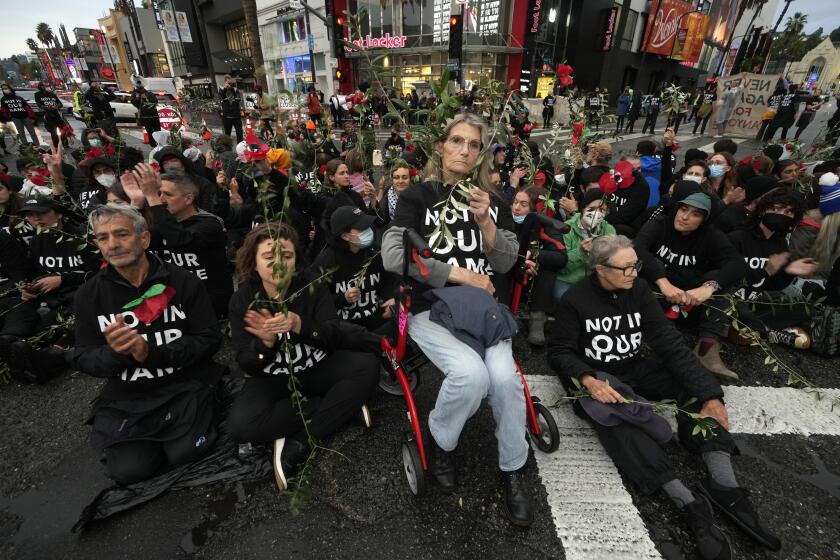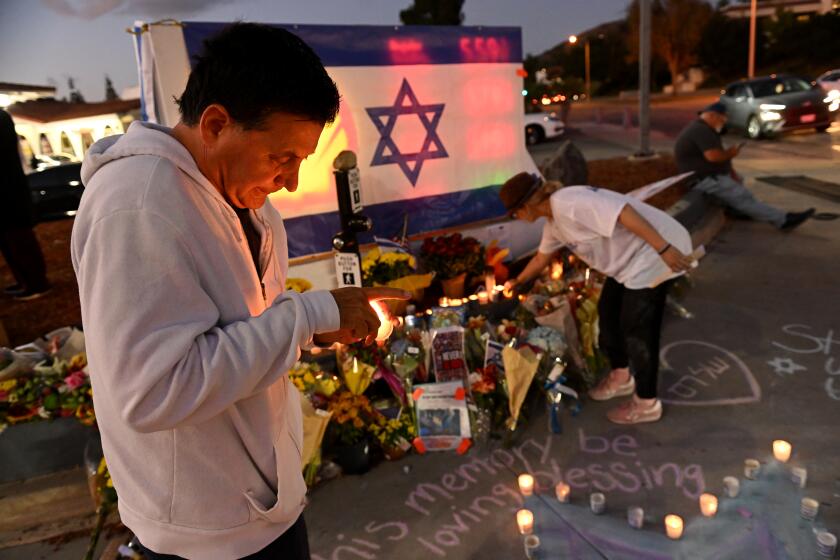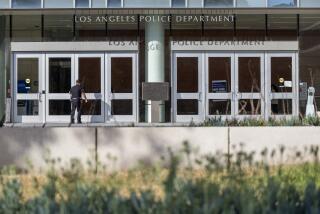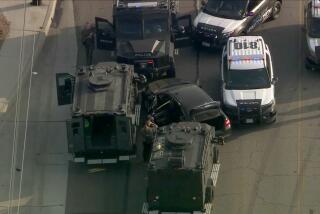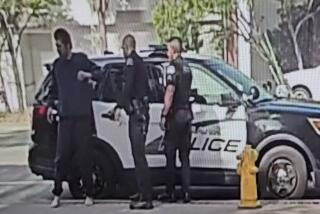Moorpark professor arrested in death of Jewish protester Paul Kessler in Thousand Oaks
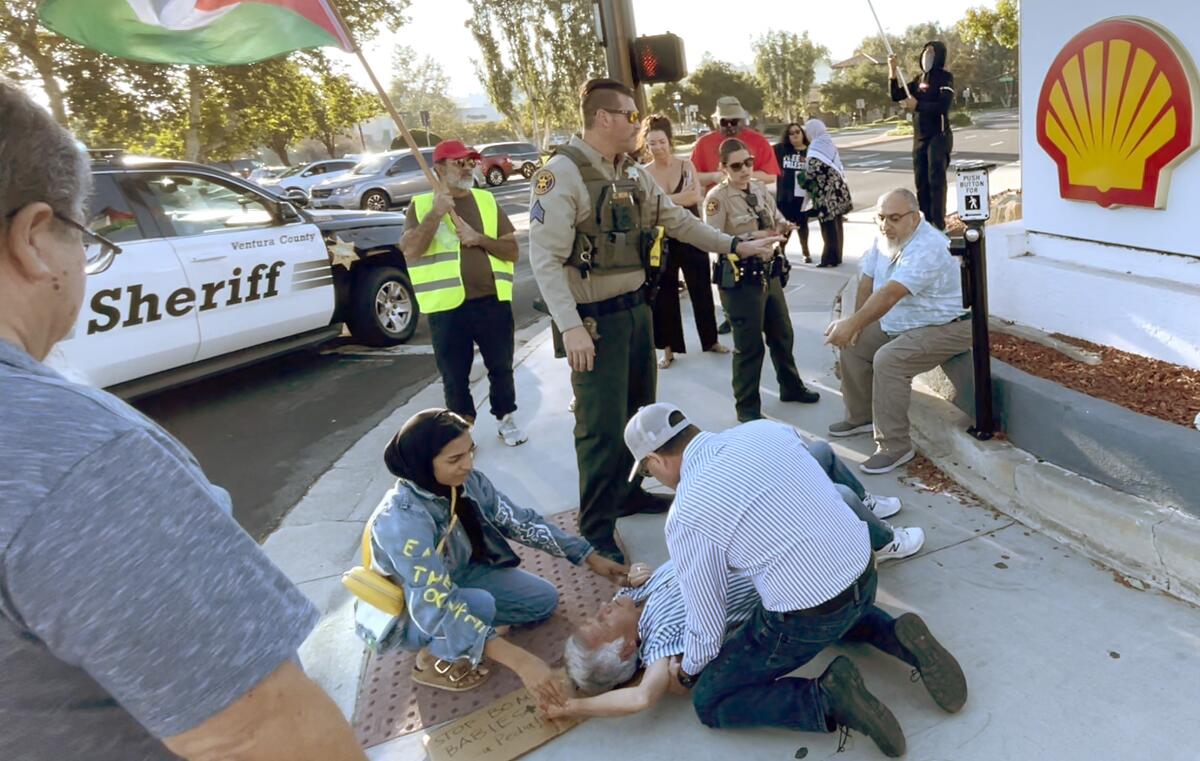
- Share via
A Moorpark College professor has been arrested on suspicion of involuntary manslaughter in the death of a Jewish protester who suffered head injuries during clashes between pro-Palestinian and pro-Israel demonstrators earlier this month in Thousand Oaks.
Loay Abdelfattah Alnaji, 50, of Moorpark was arrested early Thursday at his Moorpark home in the death of Paul Kessler, the Ventura County Sheriff’s Department announced in a news release. Alnaji is being held in lieu of $1 million bail.
Ventura County Dist. Atty. Erik Nasarenko announced late Thursday that his office planned to file two felony charges — involuntary manslaughter and battery causing serious bodily injury — against Alnaji in Kessler’s death. Officials planned to release more information on the case Friday morning.
Loay Abdelfattah Alnaji, 50, faces felony charges of involuntary manslaughter and battery in the death of Paul Kessler, Ventura County D.A. announces.
“Throughout their investigation, prosecutors have been in daily consultation with the Sheriff’s Office and are finalizing review of the evidence,” the district attorney’s office said in a statement.
When reached at his home in the days after Kessler’s death, Alnaji declined to comment to The Times. An attorney for the professor has not been identified.
Kessler, who was counterprotesting in support for Israel opposite a Free Palestine rally on Nov. 5, died hours after he fell backward during a confrontation with Alnaji and struck his head on the ground.
Ventura County sheriff’s officials did not make an immediate arrest, saying they had to unravel conflicting witness statements about what led to Kessler’s fall. It wasn’t immediately clear what new evidence, if any, led to the arrest Thursday — more than a week after Kessler died.
Alnaji was booked into the Ventura County Main Jail shortly after 9 a.m. Thursday, and is slated to appear in court Monday afternoon, according to booking records.
The death of a 69-year-old Jewish man during a confrontation at dueling protests over the Israel-Hamas war has increased fear and grief in the Conejo Valley.
An autopsy determined that Kessler died as a result of a blunt force injury to the back of his head, consistent with a fall, and the death was ruled a homicide, according to Ventura County Chief Medical Examiner Christopher Young.
However, Young said the manner of death doesn’t necessarily point to criminal intent, only that the “death occurred at the hands of another person or the actions of another person contributed to the death of a person.”
Kessler also had “nonlethal injuries” on the left side of his face, which Young said could have been caused by a blow to the face.
The incident was reported just after 3:20 p.m. on Nov. 5 at Westlake Boulevard and Thousand Oaks Boulevard, where about 75 people had gathered at the intersection, according to the Ventura County Sheriff’s Office.
Kessler, of Thousand Oaks, fell backward and struck his head on the ground during an altercation with Alnaji, deputies said. When authorities arrived, Kessler was conscious and bleeding from his head and mouth, Sheriff Jim Fryhoff said. Kessler remained conscious at the hospital, but his condition deteriorated and he was pronounced dead just after 1 a.m. on Nov. 6, Young said.
The Jewish Federation of Greater Los Angeles said that Thursday’s arrest “shows that violence towards our Jewish community will not be tolerated.”
“We will continue to monitor the case to help ensure justice is served,” the group said in a statement. “Our heartfelt condolences continue to be with the family of Paul Kessler, and may his memory forever be a blessing.”
Rabbi Ari Averbach, of Temple Etz Chaim in Thousand Oaks, where Kessler and his family were members, said Thursday’s arrest provided his community a reprieve after more than a week of despair.
“There’s relief that the wheels of justice are turning, things are moving forward,” Averbach said, adding that it had been troubling to think that there might have been no recourse for an altercation in which someone died.
“There shouldn’t be hate or violence between neighbors and hopefully that’s a message that’s being sent out at this point,” Averbach said. He still wants to learn more about the case, including whether or not Alnaji will face hate crime charges — something that officials had previously said was part of the investigation.
But Averbach is also urging people to trust law enforcement.
“Our community will be watching to see what happens next,” he said. “The fact that this happened means there’s a lot happening behind the curtain that we don’t know about.”
Dan Meisel, regional director for the Anti-Defamation League for the Santa Barbara, tri-counties region, said in a post on X that the charges filed against Alnaji “send the message that no form of violence or identity-based hate will be tolerated in our community.”
Hundreds of demonstrators calling for a Gaza cease-fire shut down the intersection of Hollywood Boulevard and Highland Avenue on Wednesday.
Until the arrest, sheriff’s officials had identified the suspect only as a 50-year-old man from Moorpark who cooperated with deputies, telling officials that he was “involved in an altercation with Mr. Kessler,” Fryhoff said. The suspect was among those who called 911 after Kessler fell, the sheriff said.
The day after the deadly confrontation, deputies briefly detained Alnaji after a traffic stop in Simi Valley while investigators executed a search warrant at his home.
The sheriff said surveillance video from a gas station adjacent to the protest did not provide a clear view of the incident, noting that his agency had footage from both before and after the confrontation — but not of the interaction. Authorities on Thursday continued to ask the public to submit to authorities any video or images from that day.
One video reviewed by The Times recorded after Kessler fell showed Alnaji sitting on the curb in front of the gas station, wearing cargo pants and a safari shirt with a long, gray beard. A female deputy was captured on the video taking photos of his hands and asking him questions, at one point asking, “So you tried to hit the phone?”
The video didn’t capture the professor talking.
A neighbor who lives across the street from the professor said that the day after the incident, a police car sat outside her house all day. The woman, who declined to give her name, said police entered the house around 7 p.m. and stayed for an hour, taking items with them when they left.
Alnaji is a professor of computer science at Moorpark College who has espoused pro-Palestinian stances in the past on social media.
The Ventura County Community College District, which includes Moorpark College, said in a statement Thursday that Alnaji was placed on administrative leave following his arrest.
“Necessary protocols have been taken to ensure the safety and well-being of our students, faculty and staff, which will remain our top priority,” the community college district said. “VCCCD has been in communication with law enforcement throughout this process.”
Much of Alnaji’s social media presence, which was publicly visible a week ago, appeared to be deleted by Thursday. His professor page at Moorpark College also appeared to be down.
Alnaji, who was born in Kuwait, according to jail records, previously worked at Al Ain University in the United Arab Emirates, according to a faculty page there. He had studied computer science in Jordan before completing a master’s degree at Cal State University. He received his doctorate in business administration from Argosy University in Los Angeles in 2005.
During the following 18 years, he worked as a software contractor for Countrywide Financial and taught courses at Devry University, according to his LinkedIn account. He was listed as a full-time professor at the Ventura County Community College District, though that page was removed sometime after his name was connected to Kessler’s death.
On RateMyProfessors.com, a review site that allows anyone to assign ratings to professors and campuses of American, Canadian and British institutions, students expressed a wide variety of opinions of Alnaji.
“He is so funny and helpful,” wrote one reviewer.
“If you have any error in your code, he will give you a zero,” wrote another.
Overall, most of the dozens of reviewers fell into one of two groups — those who praised his personality and willingness to engage during office hours, and those who thought he was too exacting as a professor.
Alnaji also maintained a bare-bones website, surahmeaning.com, displaying Quran verses in English and Arabic. His professor page linked to the site and the domain was registered to his home address in Moorpark.
Paul Kessler, a pro-Israel counter-protester, died hours after a confrontation with a pro-Palestinian demonstrator. Officials have identified a suspect, but no one has been arrested.
Authorities have still not released information on what happened, but the arrest on suspicion of manslaughter begins to clarify the confrontation between Alnaji and Kessler.
“You’d expect to see [an] involuntary manslaughter charge in a situation where someone in a negligent way causes the death of another — meaning they didn’t intend on killing another person but their actions did not rise to the reasonable duty of care,” said Lou Shapiro, a criminal defense attorney in Los Angeles.
Shapiro said it’s a common charge. For example, a driver who is speeding or runs a red light and kills someone can be charged with vehicular manslaughter. Manslaughter also can be charged in cases where someone is punched, falls down, hits their head and dies from that injury. The issue is foreseeability, Shapiro said. The less foreseeable the death is from the action, the more likely it is to be an involuntary manslaughter charge and not murder.
“Maybe [Alnaji] took things too far or hit too hard, or just by hitting Kessler, may have had the bad luck of Kessler falling in a way where he ended up dying,” Shapiro said.
Dmitry Gorin, a former L.A. County prosecutor, said that even with a minimum amount of force that causes death, prosecutors “have an argument for charges.” However, he noted that involuntary manslaughter in physical altercations is rarely filed.
“These cases rise and fall [based on] who did what first,” Gorin said. “If you strike someone with an object like a megaphone, it would give the [district attorney] a strong argument of criminal negligence, and, if they can prove that, they may have a strong case.”
He said it will “come down to what the witnesses say.”
More to Read
Sign up for Essential California
The most important California stories and recommendations in your inbox every morning.
You may occasionally receive promotional content from the Los Angeles Times.
